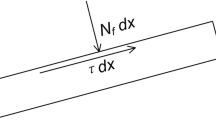Abstract
The dynamics of a flexible cantilevered pipe conveying fluid have been researched for several decades. It is known that the flexible pipe undergoes self-excited vibration when the flow speed exceeds a critical speed. This instability phenomenon is caused by nonconservative forces. From a mathematical point of view, the system has a characteristic of non-selfadjointness and the linear eigenmodes can be complex and non-orthogonal to each other. As a result, such a mathematical feature of the system is directly related to the instability phenomenon. In this study, we propose a method of experimentally identifying the complex mode from experimentally obtained time histories and decomposing the linear mode into real and imaginary components. In nonlinear analysis, we show that the nonlinear effects of practical systems on the mode in the steady-state self-excited oscillation are small. The real and imaginary components identified using the proposed method for experimental steady-state self-excited oscillations are compared with those obtained in the theoretical analysis, thus validating the proposed identification method.











Similar content being viewed by others
Data availability statement
The manuscript has no associated data.
Change history
31 May 2022
A Correction to this paper has been published: https://doi.org/10.1007/s11071-022-07540-1
References
Amabili, M., Sarkar, A., Païdoussis, M.: Chaotic vibrations of circular cylindrical shells: Galerkin versus reduced-order models via the proper orthogonal decomposition method. J. Sound Vib. 290(3–5), 736–762 (2006)
Ashley, H., Haviland, G.: Bending vibrations of a pipe line containing flowing fluid (1950)
Bajaj, A., Sethna, P.: Flow induced bifurcations to three-dimensional oscillatory motions in continuous tubes. SIAM J. Appl. Math. 44(2), 270–286 (1984)
Bajaj, A., Sethna, P.T., Lundgren, T.: Hopf bifurcation phenomena in tubes carrying a fluid. SIAM J. Appl. Math. 39(2), 213–230 (1980)
Benjamin, T.B.: Dynamics of a system of articulated pipes conveying fluid-i. Theory. Proc. R. Soc. Lond. A 261(1307), 457–486 (1962)
Bishop, R.E.D., Fawzy, I.: Free and forced oscillation of a vertical tube containing a flowing fluid. Philos. Trans. R. Soc. Lond. Ser. A Math. Phys. Sci. 284(1316), 1–47 (1976)
Bourrières, F.J.: Sur un phénomène d’oscillation auto-entretenue en mécanique des fluides réels. No. no. 147 in Publications scientifiques et techniques du Ministère de l’air : travaux de l’Institut de mécanique dela Faculté des sciences de Paris. Blondel la Rougery : Gauthier-Villars (1939)
Chen, S., Rosenberg, G.: Vibrations and stability of a tube conveying fluid. Tech. rep., Argonne National Lab., Ill (1971)
Dodds, H.L., Runyan, H.L.: Effect of high-velocity fluid flow on the bending vibrations and static divergence of a simply supported pipe, vol. 2870. National Aeronautics and Space Administration (1965)
Ghayesh, M.H., Païdoussis, M.P., Modarres-Sadeghi, Y.: Three-dimensional dynamics of a fluid-conveying cantilevered pipe fitted with an additional spring-support and an end-mass. J. Sound Vib. 330(12), 2869–2899 (2011)
Gregory, R.W., Païdoussis, M.P.: Unstable oscillation of tubular cantilevers conveying fluid i. Theory. Proc. R. Soc. Lond. A 293(1435), 512–527 (1966)
Gregory, R.W., Païdoussis, M.P.: Unstable oscillation of tubular cantilevers conveying fluid ii. Experiments. Proc. R. Soc. Lond. A 293(1435), 528–542 (1966)
Jendrzejczyk, J., Chen, S.: Experiments on tubes conveying fluid. Thin Walled Struct. 3(2), 109–134 (1985)
Jensen, J.S.: Articulated pipes conveying fluid pulsating with high frequency. Nonlinear Dyn. 19(2), 173–193 (1999)
Jin, J., Zou, G.: Bifurcations and chaotic motions in the autonomous system of a restrained pipe conveying fluid. J. Sound Vib. 260(5), 783–805 (2003)
Kirillov, O.N.: Nonconservative stability problems of modern physics. De Gruyter, Berlin (2013)
Lundgren, T., Sethna, P., Bajaj, A.: Stability boundaries for flow induced motions of tubes with an inclined terminal nozzle. J. Sound Vib. 64(4), 553–571 (1979)
Modarres-Sadeghi, Y., Semler, C., Wadham-Gagnon, M., Païdoussis, M.: Dynamics of cantilevered pipes conveying fluid. Part 3: three-dimensional dynamics in the presence of an end-mass. J. Fluids Struct. 23(4), 589–603 (2007)
Nayfeh, A.H.: Introduction to perturbation techniques. John Wiley & Sons, New Jersey (2011)
Païdoussis, M., Li, G.: Pipes conveying fluid: a model dynamical problem. J. Fluids Struct. 7(2), 137–204 (1993)
Paidoussis, M.P.: Dynamics of flexible slender cylinders in axial flow part 1. Theory. J. Fluid Mech. 26(4), 717–736 (1966)
Paidoussis, M.P.: Fluid-structure interactions: slender structures and axial flow, vol. 1. Academic Press, Cambridge (1998)
Paidoussis, M.P.: Fluid-structure interactions: slender structures and axial flow, vol. 2. Academic press, Cambridge (2003)
Paidoussis, M.P., Issid, N.: Dynamic stability of pipes conveying fluid. J. Sound Vib. 33(3), 267–294 (1974)
Paidoussis, M.P., Moon, F.C.: Nonlinear and chaotic fluidelastic vibrations of a flexible pipe conveying fluid. J. Fluids Struct. 2(6), 567–591 (1988)
Prasad, S.N., Herrmann, G.: The usefulness of adjoint systems in solving nonconservative stability problems of elastic continua. Int. J. Solids Struct. 5(7), 727–735 (1969)
Sarkar, A., Paidoussis, M.: A cantilever conveying fluid: coherent modes versus beam modes. Int. J. Non Linear Mech. 39(3), 467–481 (2004)
Sazesh, S., Shams, S.: Vibration analysis of cantilever pipe conveying fluid under distributed random excitation. J. Fluids Struct. 87, 84–101 (2019)
Seyranian, A.P., Mailybaev, A.A.: Multiparameter stability theory with mechanical applications, vol. 13. World Scientific, Singapore (2003)
Steindl, A., Troger, H.: Nonlinear three-dimensional oscillations of elastically constrained fluid conveying viscoelastic tubes with perfect and broken o (2)-symmetry. Nonlinear Dyn. 7(2), 165–193 (1995)
Sugiyama, Y., Kawagoe, H., Kishi, T., Nishiyama, S.: Studies on the stability of pipes conveying fluid:(the combined effect of a spring support and a lumped mass). JSME Int. J. Ser. 1 Solid Mech. Strength Mater. 31(1), 20–26 (1988)
Sugiyama, Y., Kumagai, Y., Kishi, T., Kawagoe, H.: Studies on stability of pipes conveying fluid: the effect of a lumped mass and damping (in Japanese). Trans. JPN. Soc. Mech. Eng. Ser. C 51(467), 1506–1514 (1985)
Thomsen, J.J.: Vibrations and stability, order and chaos (1997)
Wang, Y., Wang, L., Ni, Q., Dai, H., Yan, H., Luo, Y.: Non-planar responses of cantilevered pipes conveying fluid with intermediate motion constraints. Nonlinear Dyn. 93(2), 505–524 (2018)
Yamashita, K., Furuya, H., Yabuno, H., Yoshizawa, M.: Nonplanar vibration of a vertical fluid-conveying pipe (effect of horizontal excitation at the upper end). J. Vib. Acoust. 136(4) (2014)
Yamashita, K., Nishiyama, N., Katsura, K., Yabuno, H.: Hopf-hopf interactions in a spring-supported pipe conveying fluid. Mech. Syst. Signal Process. 152, 107390 (2021)
Yamashita, K., Yagyu, T., Yabuno, H.: Nonlinear interactions between unstable oscillatory modes in a cantilevered pipe conveying fluid. Nonlinear Dyn. 98(4), 2927–2938 (2019)
Yoshizawa, M., Suzuki, T., Takayanagi, M., Hashimoto, K.: Nonlinear lateral vibration of a vertical fluid-conveying pipe with end mass (special issue on nonlinear dynamics). JSME Int. J. Ser. C 41(3), 652–661 (1998)
Zhang, Y., Yao, M., Zhang, W., Wen, B.: Dynamical modeling and multi-pulse chaotic dynamics of cantilevered pipe conveying pulsating fluid in parametric resonance. Aerosp. Sci. Technol. 68, 441–453 (2017)
Acknowledgements
The authors thank Professor Emeritus M. Yoshizawa for useful discussions and Edanz for editing a draft of this manuscript. This work was supported by a grant from the University of Tsukuba jyu-ten-haibun.
Author information
Authors and Affiliations
Corresponding author
Ethics declarations
Conflict of interest
The authors declare that they have no conflict of interest.
Additional information
Publisher's Note
Springer Nature remains neutral with regard to jurisdictional claims in published maps and institutional affiliations.
Appendices
Nonlinear term
The nonlinear term in Eq. (34) is expressed as
Non-selfadjointness of the system
We introduce \(\varPsi _{n1}\) as the adjoint function of \(\varPhi _{n1}\), which satisfies
Considering the boundary conditions of Eq. (33), we note that \(\varPsi _{n1}\) is the solution to the boundary value problem
According to Eqs. (B.2) and (B3), the differential equation satisfied by \(\varPsi _{n1}\) does not correspond to Eqs. (32) and (33), which \(\varPhi _{n1}\) satisfies. Therefore, \(\varPsi _{n1}\) is not the eigenmode and this system has non-selfadjointness. When we assume the flow velocity to be zero in Eqs. (B.2) and (B.3), these equations correspond to Eqs. (32) and (33). Therefore, the fluid conveying in the pipe makes this system non-selfadjoint.
\(\varPhi _{n1}\) and \(\varPsi _{m1}\) satisfy \(\int _0^1 \varPhi _{n1}{\overline{\varPsi }}_{m1}ds=\delta _{nm}\), where \(\delta _{nm}\) is Kronecker’s delta. Hence, from this property, the adjoint function plays an important role in the analysis of non-selfadjoint system and is used to obtain the eigenvalue [26]. Also, the application of the orthogonality yields the solvability condition related to the amplitude equation in nonlinear non-selfadjoint systems [19]. In this manuscript, we use the adjoint function in order to derive the solvability condition of \(\varPhi _{n3}\)as in Sect. 3. But, the adjoint function is not necessary for obtaining the complex mode shape experimentally as mentioned in Sect. 4.
Identification of flexural rigidity
We need the flexural rigidity EI as a parameter when we calculate the eigenmode theoretically. In this study, we determined the flexural rigidity EI of the pipe so that the natural frequency of free vibration without internal flow for the first mode obtained experimentally is equal to that obtained theoretically. Using this flexural rigidity EI, we find that the frequency of the second mode obtained experimentally is similar to that calculated theoretically as shown in Table 4.
Rights and permissions
About this article
Cite this article
Higuchi, E., Yabuno, H. & Yamashita, K. Method of experimentally identifying the complex mode shape of the self-excited oscillation of a cantilevered pipe conveying fluid. Nonlinear Dyn 109, 589–604 (2022). https://doi.org/10.1007/s11071-022-07460-0
Received:
Accepted:
Published:
Issue Date:
DOI: https://doi.org/10.1007/s11071-022-07460-0




